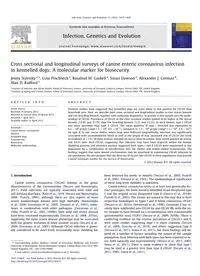
2012 Cross sectional and longitudinal surveys of canine enteric coronavirus infection in kennelled dogs_ A molecular mar PDF
Preview 2012 Cross sectional and longitudinal surveys of canine enteric coronavirus infection in kennelled dogs_ A molecular mar
Cross sectional and longitudinal surveys of canine enteric coronavirus infection in kennelled dogs: A molecular marker for biosecurity Jenny Stavisky a,⇑, Gina Pinchbeck a, Rosalind M. Gaskell a, Susan Dawson a, Alexander J. German b, Alan D. Radford a a Institute of Infection and Global Health, School of Veterinary Science, University of Liverpool, Leahurst Campus, Wirral CH64 7TE, United Kingdom b Institute of Ageing and Chronic Disease, School of Veterinary Science, University of Liverpool, Leahurst Campus, Wirral CH64 7TE, United Kingdom a r t i c l e i n f o Article history: Received 24 January 2012 Received in revised form 30 March 2012 Accepted 7 April 2012 Available online 21 April 2012 Keywords: Canine enteric coronavirus Shelters Kennelled dogs Transmission Biosecurity Molecular epidemiology a b s t r a c t Previous studies have suggested that kennelled dogs are more likely to test positive for CECoV than household pets. Here we describe both cross sectional and longitudinal studies in two rescue kennels and two boarding kennels, together with molecular diagnostics, to provide a new insight into the epide- miology of CECoV. Prevalence of CECoV in the cross sectional studies tended to be higher in the rescue kennels (13.8% and 33.3%) than the boarding kennels (5.3% and 13.5%). In each kennel, type I CECoV was more prevalent than type 2 CECoV. The mean quantity of type I detected was equivalent to 6.3 � 108 gc/gm (range = 5 � 106, 8.5 � 1011), compared to 1.3 � 108 gc/gm (range = 3 � 106, 2.4 � 1010) for type II. In one rescue shelter where dogs were followed longitudinally, infection was significantly associated with accommodation block as well as the length of stay (increased risk of CECoV per week in residence of �1.9). Of those animals sampled on two or more occasions, none tested positive on arrival, and 54.5% later shed CECoV, suggesting that infection may have been acquired within the kennel. Shedding patterns and sequence analysis suggested both types I and II CECoV were maintained in this population by a combination of introductions into the shelter and within-shelter transmission. The findings suggest that some kennel environments may be important in maintaining CECoV infection in the population. We also propose that the diversity of viruses like CECoV in these populations may provide a novel surrogate marker for the success of biosecurity. � 2012 Elsevier B.V. All rights reserved. 1. Introduction Canine enteric coronavirus (CECoV) belongs to the genus Alpacoronavirus of the Coronaviridae (Decaro and Buonavoglia, 2011). Field infections are typically associated with mild and self-limiting diarrhoea, (Binn et al., 1974; Decaro and Buonavoglia, 2008; Pratelli, 2005), although there are also reports of more severe haemorrhagic disease with high mortality (Buonavoglia et al., 2006; Evermann et al., 2005; Tennant et al., 1993), some- times in combination with other pathogens (Evermann et al., 1980; Pratelli et al., 2001, 1999b). Both mild and severe disease have been recreated experimentally (Decaro et al., 2008, 2010a), suggesting the more severe disease phenotype may be associated with the genetic evolution of more virulent strains (Decaro et al., 2008; Evermann et al., 2005). Although CECoV infection is gener- ally considered to be short-lived, occasionally virus shedding has been detected for weeks to months (Decaro et al., 2005; Pratelli et al., 2002; Tennant et al., 1991). The epidemiological significance of these long-term shedders is unknown. Canine enteric coronavirus exists as at least two genetically dis- tinct genotypes, the more recently identified strain designated type I, and the original strain designated type II (Decaro et al., 2010b; Pratelli et al., 2003). The strains are named in this way due to their respective homologies to types I and II feline coronavirus (FCoV) (Decaro et al., 2010a; Herrewegh et al., 1998). Genotype II has re- cently been subdivided into CECoV IIa and CECoV IIb, with the lat- ter thought to have formed via a recombination with transmissible gastroenteritis virus (TGEV) (Decaro et al., 2009, 2010b). There is conflicting evidence on the relative prevalence of CECoV I and II, with some studies suggesting type I is more common (Decaro et al., 2005; Stavisky et al., 2010), and others suggesting type II (Decaro et al., 2011; Soma et al., 2011), but these findings will de- pend on a number of factors including the nature of the sample population. Dual infection with both types has been reported to oc- cur, both naturally and experimentally (Decaro et al., 2011, 2005; Soma et al., 2011). There is some evidence to show that type I may be shed at a greater titre than type II CECoV (Decaro et al., 2011, 2005; Soma et al., 2011). 1567-1348/$ - see front matter � 2012 Elsevier B.V. All rights reserved. http://dx.doi.org/10.1016/j.meegid.2012.04.010 ⇑ Corresponding author. Address: School of Veterinary Medicine and Science, University of Nottingham, Sutton Bonington Campus, College Road, Leics LE12 5RD, United Kingdom. Tel.: +44 1159516660. E-mail address:
